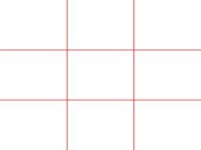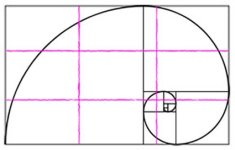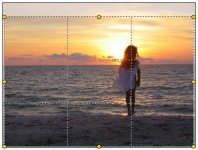Horoscope Fish
Senior Member
For the second installment here I figured I'd cover what is probably the most talked about and single most suggested compositional guideline (rule) I know of: The Rule of Thirds. This compositional guideline is much more flexible and is applicable in many more ways than I often see covered in one place however, so I am going to attempt to cover all the most common applications for this particular guideline. If I leave something out please feel free to blast me for it. Bear in mind these tutorials are meant to be conversation starters, not textbooks. Now before I go into detail about applying the Rule of Thirds, I think a good question to ask is why does composition matter, how does it help create a more visually appealing photo and what is it about this particular guideline that will elevate my photo from boring snapshot, to the marvel of compositional perfection that I so deeply crave to achieve and subsequently charge for? Damned if I know.
Okay, that was a joke.
Sort of...
*cough*
Like all things aesthetic, all things visually appealing, composition matters to our mind and our hard-wired human psychology. Our brains are excellent at finding patterns and creating order out of chaos and our brains do this for us this intuitively. If our brain is focused on a photo and it finds sensible order that sensible order minimizes fatigue and stress and we will intuitively feel more drawn to the image; our brains will be pleased and relaxed. I don't want to get too bogged down in the psychology of composition, though, so I'm going to move on to the actual application of The Rule of Thirds.
The Rule of Thirds refers to the idea of dividing your frame into... You guessed it, thirds. We do this by superimposing a sort of imaginary Tic-Tac-Toe board across the frame which creates nine separate areas like you see here:

The "Tic Tac Toe" board of composition.
This grid gives us eight distinct points of reference: two horizontal lines, two vertical lines and four points of intersection which I call, "bulls eyes" personally. Other people have other less creative names for them so feel free to make up your own. The most basic concept behind this grid is superimposing one of these "bulls eyes" on your subject, just like you'd put the cross hairs of a rifle scope on your target (which is why I call them "bulls eyes"). Here's a illustrative illustration to illustrate my point:

Compositional targeting-reticles.
This "targeting approach" is, I think it safe to say, the most common and most conventional use of this particular compositional tool. This thirds concept is ubiquitous, being used not only in photography but also in painting, drawing, architecture and graphic design as well. So much so that many cameras and digital image software applications can overlay such a grid on images for you as an aid in composition either before (e.g. framing the shot) or after (e.g. cropping in 'post). Numerous cameras come with the option to superimpose the Two Thirds grid on the viewfinder as well. In fact, one of my old Canon P&S cameras would do that and it's a feature I miss on my current DSLR.
Known as "Phi" in mathematics it is related to what is known as the Fibonacci Sequence and should not be confused with "Pi" which is totally different and not related to what we're discussing here. The funny thing about all of *this*, meaning Phi and so forth, is how these numbers and the proportions (one could say "compositions") that follow from them, pop up all over the place. And by "all over the place" I really do mean ALL OVER. As in, it's like some kind of weird, Universal Constant sort of thing. The reason why it so ubiquitous is also mathematically explainable but what concerns us as photographers is how this ratio shows itself. Most famously I think it safe to say, in the formation of the nautilus shell but it also manifests itself in botany, the human body and the bodies of all other animals and even in the freaking formation of galaxies in outer space. That's pretty damn big if you ask me! It all starts to get pretty heavy when you really start looking into it and for the really curious here's a short YouTube video that scratches the surface of the Fibonacci sequence. While it is a little silly, it was one of the few videos I could find that seemed both entertaining and didn't go off the deep end with the mystical magical type stuff.

Rule of Thirds grid (pink) superimposed on a Fibonacci spiral (black).
Yes, that popping sound you just heard *was* your mind being blown...
So, to my way of thinking by using the Rule of Thirds we touch on something far deeper, and this extraordinary connection can add power to our photography which is why I think all this stuff is important. This tool, or guideline, allows us to bring a sense of order out of chaos; it creates a harmony and an inherent balance which is both calming and pleasing to look at.
So, for whatever reason that's how it is... Our brains look to those points for visual reference and knowing we have a natural tendency to do that, we can exploit it for our own compositional ends by placing key elements in our frame so they fall on, or close to, an intersecting point (bulls eye). This one concept will elevate the compositional power of your shot drastically. While beginning photographers tend to want to center the subject in the frame, the resultant perfect symmetry is also static and boring. Symmetry is a tool that can be used, but it must be first understood in order to be applied with dramatic effect. Asymmetric subjects, typically, do not lend themselves well to symmetrical framing. Yes, there ARE exceptions, I'm aware of this; there are always going to be those annoying exceptions. However, when in doubt, putting your subject ON TARGET, as I like to say, meaning on a bulls eye, will almost never be a bad idea. While there might be better ideas, using the Rule of Thirds is almost universally Never a Bad Idea.

Cropping for 1/3 sky, 2/3 foreground; subject on a vertical; a classic two-fer.
When it comes to portraits (which I typically hate doing) try keeping your subject's eye's on, or near a "line", or "target" their face by putting a bulls eye on one of their eyes. Again, not always possible, not always the best answer but that's why these are guidelines and again, you don't need to take a micrometer to this; the bulls eye does not need to perfectly intersect the center of the pupil to the n'th degree to be effective. Nor do key elements need to be perfectly aligned on a vertical or horizontal line; work within a guideline but don't be enslaved by it. We could go into other, more arcane, uses of this grid for things like "S" curves, (Power) Diagonals and Negative Space, but those are for other tutorials. I'm all out of words on this subject, at least for now.
Here's hoping you found something useful in the above tutorial.
.......
Okay, that was a joke.
Sort of...
*cough*
Like all things aesthetic, all things visually appealing, composition matters to our mind and our hard-wired human psychology. Our brains are excellent at finding patterns and creating order out of chaos and our brains do this for us this intuitively. If our brain is focused on a photo and it finds sensible order that sensible order minimizes fatigue and stress and we will intuitively feel more drawn to the image; our brains will be pleased and relaxed. I don't want to get too bogged down in the psychology of composition, though, so I'm going to move on to the actual application of The Rule of Thirds.
The Rule of Thirds refers to the idea of dividing your frame into... You guessed it, thirds. We do this by superimposing a sort of imaginary Tic-Tac-Toe board across the frame which creates nine separate areas like you see here:

The "Tic Tac Toe" board of composition.
This grid gives us eight distinct points of reference: two horizontal lines, two vertical lines and four points of intersection which I call, "bulls eyes" personally. Other people have other less creative names for them so feel free to make up your own. The most basic concept behind this grid is superimposing one of these "bulls eyes" on your subject, just like you'd put the cross hairs of a rifle scope on your target (which is why I call them "bulls eyes"). Here's a illustrative illustration to illustrate my point:

Compositional targeting-reticles.
This "targeting approach" is, I think it safe to say, the most common and most conventional use of this particular compositional tool. This thirds concept is ubiquitous, being used not only in photography but also in painting, drawing, architecture and graphic design as well. So much so that many cameras and digital image software applications can overlay such a grid on images for you as an aid in composition either before (e.g. framing the shot) or after (e.g. cropping in 'post). Numerous cameras come with the option to superimpose the Two Thirds grid on the viewfinder as well. In fact, one of my old Canon P&S cameras would do that and it's a feature I miss on my current DSLR.
- Why... Why... Why?
Known as "Phi" in mathematics it is related to what is known as the Fibonacci Sequence and should not be confused with "Pi" which is totally different and not related to what we're discussing here. The funny thing about all of *this*, meaning Phi and so forth, is how these numbers and the proportions (one could say "compositions") that follow from them, pop up all over the place. And by "all over the place" I really do mean ALL OVER. As in, it's like some kind of weird, Universal Constant sort of thing. The reason why it so ubiquitous is also mathematically explainable but what concerns us as photographers is how this ratio shows itself. Most famously I think it safe to say, in the formation of the nautilus shell but it also manifests itself in botany, the human body and the bodies of all other animals and even in the freaking formation of galaxies in outer space. That's pretty damn big if you ask me! It all starts to get pretty heavy when you really start looking into it and for the really curious here's a short YouTube video that scratches the surface of the Fibonacci sequence. While it is a little silly, it was one of the few videos I could find that seemed both entertaining and didn't go off the deep end with the mystical magical type stuff.

Rule of Thirds grid (pink) superimposed on a Fibonacci spiral (black).
Yes, that popping sound you just heard *was* your mind being blown...
So, to my way of thinking by using the Rule of Thirds we touch on something far deeper, and this extraordinary connection can add power to our photography which is why I think all this stuff is important. This tool, or guideline, allows us to bring a sense of order out of chaos; it creates a harmony and an inherent balance which is both calming and pleasing to look at.
- How Can I Make This Knowledge Work For Me?
So, for whatever reason that's how it is... Our brains look to those points for visual reference and knowing we have a natural tendency to do that, we can exploit it for our own compositional ends by placing key elements in our frame so they fall on, or close to, an intersecting point (bulls eye). This one concept will elevate the compositional power of your shot drastically. While beginning photographers tend to want to center the subject in the frame, the resultant perfect symmetry is also static and boring. Symmetry is a tool that can be used, but it must be first understood in order to be applied with dramatic effect. Asymmetric subjects, typically, do not lend themselves well to symmetrical framing. Yes, there ARE exceptions, I'm aware of this; there are always going to be those annoying exceptions. However, when in doubt, putting your subject ON TARGET, as I like to say, meaning on a bulls eye, will almost never be a bad idea. While there might be better ideas, using the Rule of Thirds is almost universally Never a Bad Idea.
- ZOMG! What Else Can I Do With This Awesome Tool?!

Cropping for 1/3 sky, 2/3 foreground; subject on a vertical; a classic two-fer.
When it comes to portraits (which I typically hate doing) try keeping your subject's eye's on, or near a "line", or "target" their face by putting a bulls eye on one of their eyes. Again, not always possible, not always the best answer but that's why these are guidelines and again, you don't need to take a micrometer to this; the bulls eye does not need to perfectly intersect the center of the pupil to the n'th degree to be effective. Nor do key elements need to be perfectly aligned on a vertical or horizontal line; work within a guideline but don't be enslaved by it. We could go into other, more arcane, uses of this grid for things like "S" curves, (Power) Diagonals and Negative Space, but those are for other tutorials. I'm all out of words on this subject, at least for now.
Here's hoping you found something useful in the above tutorial.
.......
Last edited:
